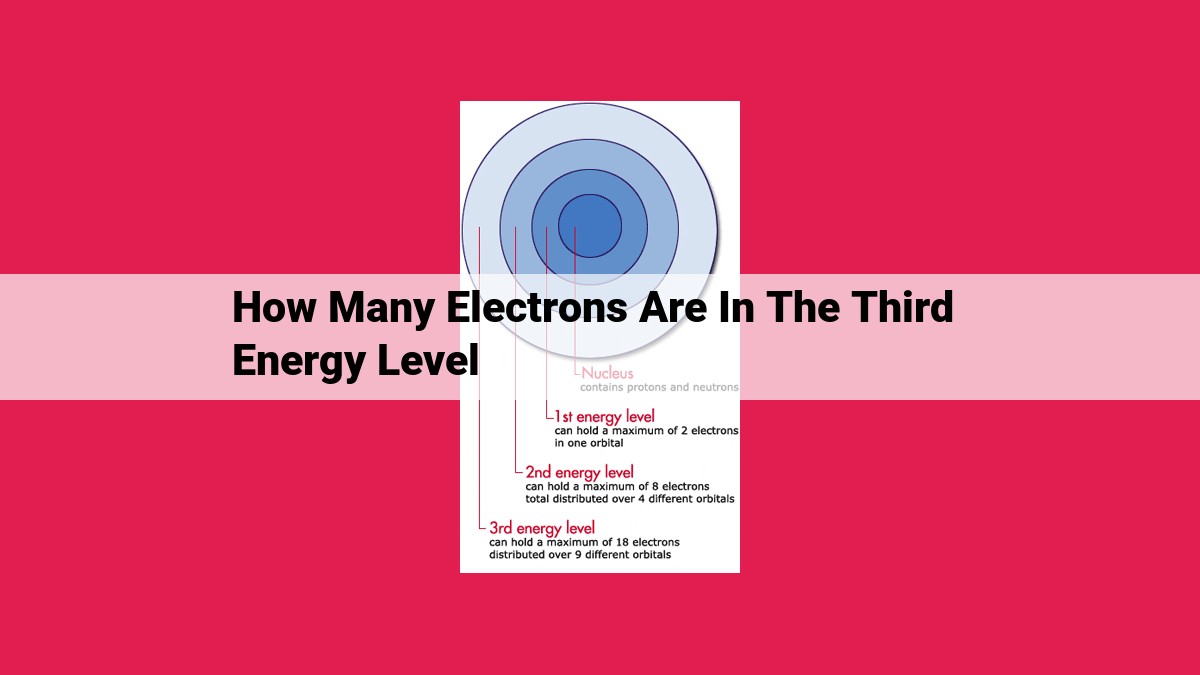Understanding The Third Energy Level: Evolving Electron Configuration And Chemical Reactivity

The third energy level is the outermost energy level in an atom, containing s, p, and d orbitals. It can accommodate up to 18 electrons, distributed as 2 in the s orbital, 6 in the p orbitals, and 10 in the d orbitals. Electron configuration, which describes the arrangement of electrons within the orbitals, plays a crucial role in determining the chemical properties of an atom. The electrons in the third energy level are the valence electrons, which participate in chemical bonding and determine the reactivity of the atom.
Unraveling the Quantum Realm: Understanding Energy Levels
In the tapestry of atoms, we find a hidden world of energy levels. These levels, like invisible ladders, dictate the behavior of electrons, the fundamental building blocks of matter. Let’s embark on an exploration of these energy levels, starting with their very essence.
Discrete Energy States: The Foundation of Energy Levels
Imagine an atom as a miniature theater, where electrons play the role of actors. Each actor, or electron, can only occupy specific seats, known as energy levels. These levels are like designated energy zones, with each zone representing a specific amount of energy. Electrons can move between these levels, but only by absorbing or releasing energy.
Ground State: The Electron’s Home Base
Every electron has a favorite seat in the theater, called the ground state. It’s the energy level where the electron feels most comfortable, with the lowest possible energy. Like a well-rested performer, an electron in the ground state is calm and stable.
Excited States: When Electrons Get a Buzz
When an electron absorbs energy, it can jump to a higher energy level, known as an excited state. These excited electrons are like actors on stage, energized and ready to perform. However, excited states are temporary, and the electron will eventually release the absorbed energy and return to its ground state.
Orbitals: The Electron’s Stage
Within each energy level, electrons occupy specific regions called orbitals. These orbitals are like the actor’s spotlight, highlighting where the electron is likely to be found. Just like how different actors have different roles, orbitals come in different shapes and sizes, each with its own unique characteristics.
The Third Energy Level: A Deeper Dive
Imagine an atom as a miniature solar system, with electrons orbiting the nucleus like planets. These electrons reside in energy levels, which are discrete energy states that determine their distance from the nucleus. The third energy level is the outermost energy level in an atom, and it holds a special significance.
This energy level has the highest energy of all energy levels, meaning that the electrons in it are the most energetic. It also has the most space, allowing for more electrons to reside in it. The third energy level consists of four types of orbitals: s, p, d, and f.
- s orbitals: These are spherical orbitals that can hold a maximum of two electrons.
- p orbitals: These are dumbbell-shaped orbitals that can hold a maximum of six electrons.
- d orbitals: These are more complex orbitals that can hold a maximum of ten electrons.
- f orbitals: These are even more complex orbitals that are found in only some atoms.
The third energy level can accommodate a maximum of 18 electrons, which is distributed as follows:
- s orbital: 2 electrons
- p orbitals: 6 electrons
- d orbitals: 10 electrons
The electron configuration of an atom refers to the distribution of its electrons in its energy levels and orbitals. For example, an atom with two electrons in its third energy level would have an electron configuration of 1s²2s²2p⁶3s².
The valence electrons in an atom are the electrons that occupy the outermost energy level, which in this case is the third energy level. These electrons are responsible for the chemical properties of the atom, as they participate in chemical reactions.
Electron Capacity in the Third Energy Level
The third energy level, often referred to as the outermost energy level in an atom, holds a significant position in the atomic structure. Unlike the inner energy levels, which are filled to capacity, the third energy level exhibits a fascinating electron distribution pattern. Within its expansive radius, the third energy level has the capability to accommodate a maximum of 18 electrons, an intriguing arrangement that plays a pivotal role in determining the chemical behavior of elements.
Delving into the specifics, the third energy level is comprised of three distinct types of orbitals: s, p, and d. The s orbital, characterized by its spherical shape, can house a maximum of two electrons. The p orbitals, on the other hand, are characterized by their dumbbell-like shape and perpendicular orientation. Each of the three p orbitals can accommodate two electrons, resulting in a total capacity of six electrons for the p sublevel. Finally, the d orbitals, with their complex shapes and distinct orientations, provide space for a remarkable ten electrons.
The distribution of electrons within the third energy level adheres to a well-defined pattern, known as electron configuration. The electron configuration of an atom dictates the arrangement of electrons across all of its energy levels, providing a unique fingerprint for each element. The third energy level is of particular importance, as it contains the valence electrons. Valence electrons are the electrons in the outermost energy level, and they play a crucial role in determining the chemical properties of an element.
In conclusion, the third energy level, as the outermost energy level in an atom, stands as a dynamic playground for electrons. Its capacity to accommodate a maximum of 18 electrons, distributed across s, p, and d orbitals, forms the basis for the electron configuration and valence electron count of an element. This intricate arrangement governs the chemical behavior and properties that make each element unique.